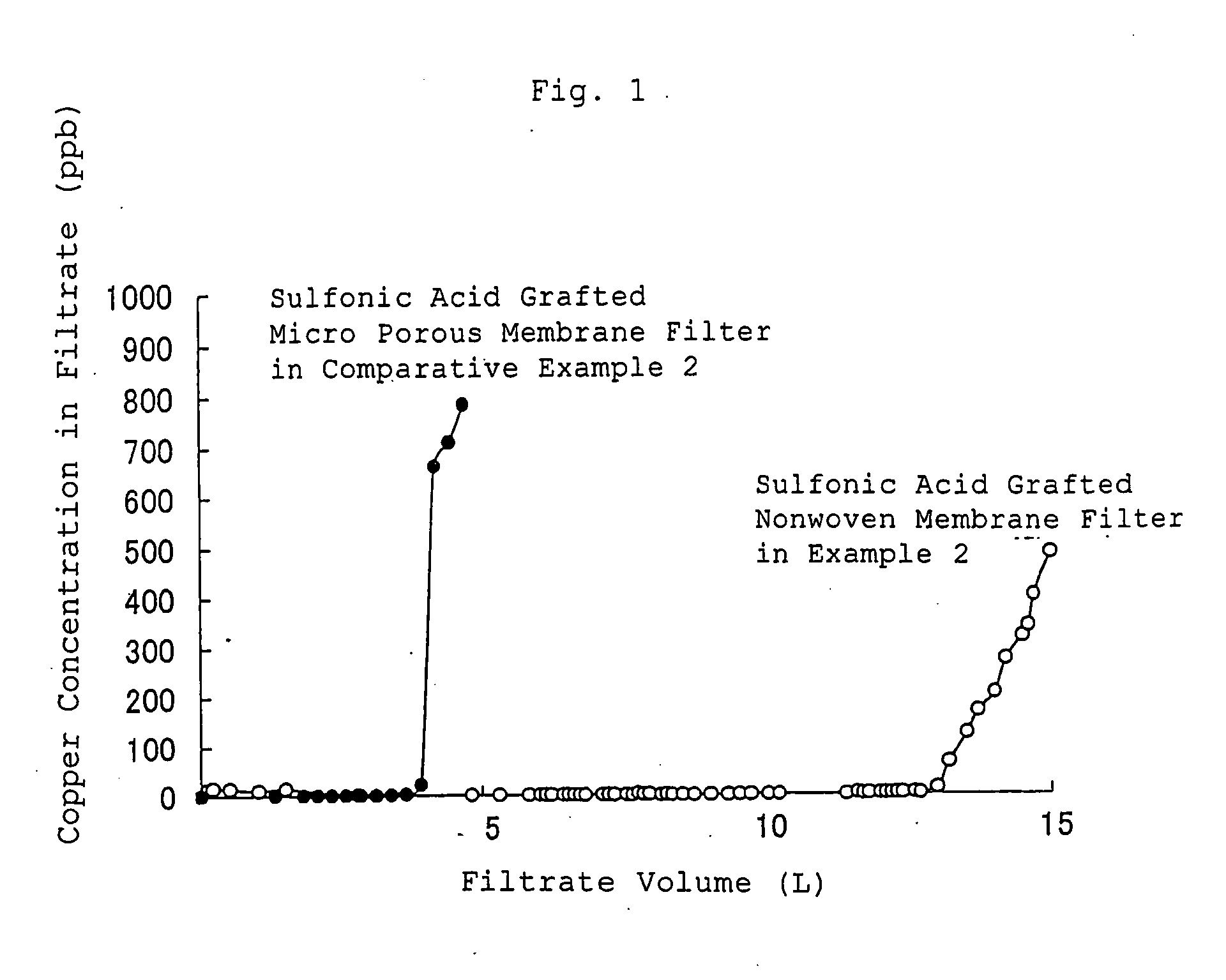Filter cartridge
a filter cartridge and filter body technology, applied in the field of filter cartridges, can solve the problems of high integration and complexity of tools including piping, the difficulty in achieving the effect of reducing the size restriction and requirements of each process device, increasing the complexity of composition, and improving the efficiency of filtering. the effect of removing metal impurities in water
- Summary
- Abstract
- Description
- Claims
- Application Information
AI Technical Summary
Benefits of technology
Problems solved by technology
Method used
Image
Examples
example 1
Preparation of Styrene Sulfonic Acid Grafted Cation Exchange Filter Cartridge 1
[0042] Under nitrogen atmosphere, 83 g of a non-woven fabric made from high density polyethylene (HDPE) [a product of E. I. du Pont de Nemours & Co., Inc., trade name “Tyvek”: average fiber diameter=0.5 to 10 μm, average pore size (measured by the bubble-point method)=5 μm, density=65 g / m2, thickness=0.17 mm] was irradiated with an electron beam with 150 kGy. This irradiated non-woven fabric was dipped in 30% styrene / toluene solution, and then placed in a glass vessel and the followed by polymerization for three hours at 50° C. in vacuo. The resulting grafted non-woven fabric was washed with toluene at 60° C. for three hours to remove undesired homopolymer. The obtained non-woven fabric was further washed with acetone and then dried at 50° C. for 12 hours to obtain 136 g of a styrene grafted non-woven fabric. The degree of grafting was 64%.
[0043] The obtained styrene grafted non-woven fabric was soaked ...
example 2
Preparation of Glycidyl Methacrylate Sulfonic Acid Grafted Cation Exchange Filter Cartridge 2
[0045] Under the conditions described in Example 1, 83 g of the non-woven fabric used in Example 1 was irradiated with an electron beam, and then dipped in glycidyl methacrylate. The sample was placed in a glass vessel, and then graft polymerization was conducted at 50° C. for three hours in vacuo. The resulting grafted non-woven fabric was taken out and soaked in dimethylformamide at 60° C. for three hours to remove undesired homopolymer. The obtained non-woven fabric was further washed with acetone and then dried at 50° C. for 12 hours to obtain 164 g of a glycidyl methacrylate grafted non-woven fabric. The degree of grafting was 97%.
[0046] The grafted non-woven fabric obtained above was soaked in a sodium sulfite in isopropanol / water mixture (sodium sulfite 80 g / sodium hydrogen sulfite 40 g / isopropanol 120 g / water 760 g), and sulfonation reaction was carried out at 90° C. for six hours....
example 3
Preparation of Iminodiethanol Grafted Chelate Filter Cartridge 3
[0048] Under the condition described in Example 1, 83 g of the non-woven fabric as in Example 1 was irradiated with an electron beam, and then dipped in chloromethylstyrene (produced by Seimi Chemical Co., Ltd., trade name “CMS-14”). The non-woven fabric was placed in a glass vessel, and polymerization reaction was conducted at 50° C. for three hours in vacuo. The resulting grafted non-woven fabric was taken out and soaked in toluene at 60° C. for three hours to remove undesired homopolymer. The obtained non-woven fabric was further washed with acetone and then dried at 50° C. under reduced pressure for 12 hours to obtain 154 g of a chloromethylstyrene grafted non-woven fabric. The degree of grafting was 85%.
[0049] The non-woven fabric prepared above was soaked in an iminodiethanol / isopropanol (weight ratio 4:6) mixture for 12 hours at 70° C. The resulting non-woven fabric was taken out, washed with methanol and pure ...
PUM
| Property | Measurement | Unit |
|---|---|---|
| pore size | aaaaa | aaaaa |
| diameter | aaaaa | aaaaa |
| pore size | aaaaa | aaaaa |
Abstract
Description
Claims
Application Information
 Login to View More
Login to View More - R&D
- Intellectual Property
- Life Sciences
- Materials
- Tech Scout
- Unparalleled Data Quality
- Higher Quality Content
- 60% Fewer Hallucinations
Browse by: Latest US Patents, China's latest patents, Technical Efficacy Thesaurus, Application Domain, Technology Topic, Popular Technical Reports.
© 2025 PatSnap. All rights reserved.Legal|Privacy policy|Modern Slavery Act Transparency Statement|Sitemap|About US| Contact US: help@patsnap.com



